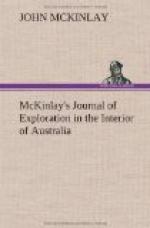10.15 started on a fresh course of 64 degrees, crossing,
11.15, a small salt lake rapidly drying up. At
11.30 altered course to 100 degrees; at twenty-five
minutes to 12 to ten minutes to 1 spelled on sandhill,
waiting for the camels, they feeling the effects of
the steep sandhill. At nine minutes past 1 altered
course to 116 degrees; at 1.15 altered course to 161
degrees; at seven minutes to 2 changed to 47 degrees;
and at 2.20 reached Lake Kadhibaerri. Found plenty
of water and watered the horses (the camels some distance
behind, quite unable to keep up) and at once proceeded
northward along the side of a large beautifully-timbered
grassed and clovered swamp (or creek about one and
a half miles across) to ascertain the fact as to the
presence of a European, dead or alive, and there found
a grave rudely formed by the natives, evidently not
one of themselves, sufficient pains not having been
taken, and from other appearances at once set it down
as the grave of a white, be he who he may. Returned
to lake to await the coming of the camels which was
not till about 5 p.m. Determined in the morning
to have the grave opened and ascertain its contents.
Whilst I went to top of sandhills, looking round me,
Mr. Hodgkinson strayed a short distance to some old
deserted native huts a short distance off, and by
and by returned bearing with him an old flattened
pint pot, no marks upon it—further evidence
that it was a white, and felt convinced that the grave
we saw was that of a white man; plenty of clover and
grasses the whole distance travelled, about eighteen
miles. Kept watch as usual (but did not intend
doing so) but just as we were retiring a fire suddenly
struck up and we thought some of the natives had followed
us, or some others had come to the lake, rather a
strange matter after dark. The fire soon after
disappeared, which made us more certain still that
it was natives. Intend spelling the camels for
a few days to recruit them; one on arrival was completely
done up and none of the others looking very sprightly.
Monday, October 21.
Up in good time; before starting for the grave went
round the lake, taking Mr. Hodgkinson with me to see
if natives were really on lake, as I did not intend
saddling the camels today if there were no natives
here, intending to leave our camp unprotected, rather
unwise, but being so short of hands could not help
it, the grave being much out of sight. Found
no natives round the lake nor any very recent traces
saving that some of the trees were still burning that
they (when here last) had lighted. We started
at once for the grave, taking a canteen of water with
us and all the arms. On arrival removed the earth
carefully and close to the top of the ground found
the body of a European enveloped in a flannel shirt
with short sleeves, a piece of the breast of which
I have taken; the flesh I may say completely cleared
from the bones, and very little hair but what must
have been decomposed; what little there was I have




